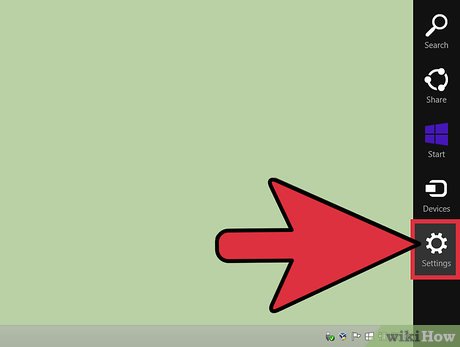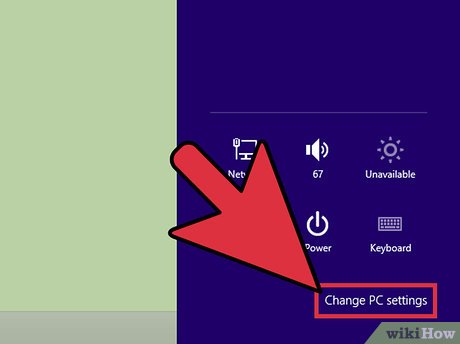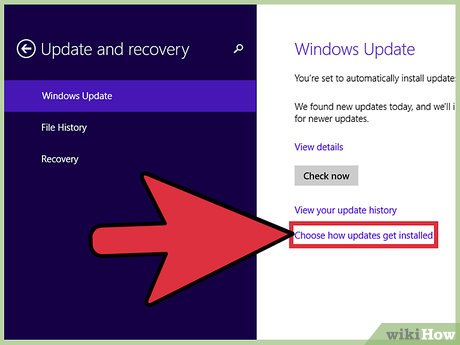How to Update Windows 8.1
Method 1 of 3:
Setting Up Automatic Updates
-
 Swipe in from the right side of your screen and select 'Settings.'
Swipe in from the right side of your screen and select 'Settings.'- If using a mouse, point to the lower right corner of your screen, move the mouse pointer up, and select 'Settings.'
-
 Click on 'Change PC settings,' then select 'Update and recovery.'
Click on 'Change PC settings,' then select 'Update and recovery.' -
 Select 'Choose how updates get installed.'
Select 'Choose how updates get installed.' -
 Click on the dropdown menu below 'Important updates,' then select 'Install updates automatically.'
Click on the dropdown menu below 'Important updates,' then select 'Install updates automatically.' -
 Place a checkmark next to 'Give me recommended updates the same way I receive important updates", then click on 'Apply.'
Place a checkmark next to 'Give me recommended updates the same way I receive important updates", then click on 'Apply.' -
 Close the 'Change settings' dialog box. Going forward, Microsoft will automatically install updates for Windows 8.1 at the time updates become available.[1]
Close the 'Change settings' dialog box. Going forward, Microsoft will automatically install updates for Windows 8.1 at the time updates become available.[1]
Method 2 of 3:
Checking For Updates Manually
-
 Swipe in from the right side of your screen and select 'Settings.'
Swipe in from the right side of your screen and select 'Settings.'- If using a mouse, point to the lower right corner of your screen, move the mouse pointer up, and select 'Settings.'
-
 Click on 'Change PC settings,' then select 'Update and recovery.'
Click on 'Change PC settings,' then select 'Update and recovery.' -
 Click on 'Check now.' Windows will begin searching for the latest updates available from Microsoft.
Click on 'Check now.' Windows will begin searching for the latest updates available from Microsoft. -
 Click on 'Install updates' if updates are available.
Click on 'Install updates' if updates are available. -
 Review and accept the license terms, then click on 'Finish.' Windows will then take a few moments to install the latest updates from Microsoft.
Review and accept the license terms, then click on 'Finish.' Windows will then take a few moments to install the latest updates from Microsoft.
Method 3 of 3:
Troubleshooting
-
 Use the Windows Update Troubleshooter to fix problems with Windows Update if you experience problems with installing the latest updates from Microsoft. The troubleshooter tool can identify and automatically resolve problems associated with Windows Updates.
Use the Windows Update Troubleshooter to fix problems with Windows Update if you experience problems with installing the latest updates from Microsoft. The troubleshooter tool can identify and automatically resolve problems associated with Windows Updates.- Navigate to Microsoft's website at http://windows.microsoft.com/en-us/windows/troubleshoot-problems-installing-updates#1TC=windows-8 and click on the 'Windows Update Troubleshooter' link in the first sentence.
- Save the .diagcab file to your desktop, then double-click on the file to launch the troubleshooter. Your computer will use the troubleshooter tool automatically resolve issues related to Windows Updates.
-
 Use System Restore to restore your computer to an earlier point in time if your computer stops responding after it restarts and begins to install updates. The System Restore feature will help resolve and reverse problems caused by new Windows Updates.
Use System Restore to restore your computer to an earlier point in time if your computer stops responding after it restarts and begins to install updates. The System Restore feature will help resolve and reverse problems caused by new Windows Updates.- Press and hold the Power button on your computer until it powers off, then press the Power button again to restart your computer. The Automatic Repair window will display on-screen.
- Click on 'Restore' next to 'System Restore.'
- Follow the on-screen prompts to reinstall Windows updates after your system is restored. In most cases, updates will install correctly after performing a system restore.
-
 Try restarting your computer if it fails to apply the latest updates from Microsoft. Some updates apply to files and services currently in use while your computer is turned on, and will not be applied until you restart your computer.[2]
Try restarting your computer if it fails to apply the latest updates from Microsoft. Some updates apply to files and services currently in use while your computer is turned on, and will not be applied until you restart your computer.[2]
3.5 ★ | 2 Vote
You should read it
- How to Update Windows
- How to Turn Off Microsoft Updates in Windows XP
- Microsoft warns, clicking Check for Updates will make the new Windows 10 update unstable
- How to Turn Off Automatic Updates in Windows 10
- Windows 10 updates will be divided into C, B, and D levels
- Spreading hacking tools helps Windows 7 still get updates even after Microsoft has stopped supporting














 How to Format Windows 8
How to Format Windows 8 How to Activate Windows 8.1 for Free
How to Activate Windows 8.1 for Free How to Reinstall Windows 8 Without a CD
How to Reinstall Windows 8 Without a CD How to Install Windows 8
How to Install Windows 8 How to Find Your Windows 8 Product Key
How to Find Your Windows 8 Product Key How to Make Windows 8 Move Deleted Favorites to the Recycle Bin Instead of Deleting Them
How to Make Windows 8 Move Deleted Favorites to the Recycle Bin Instead of Deleting Them